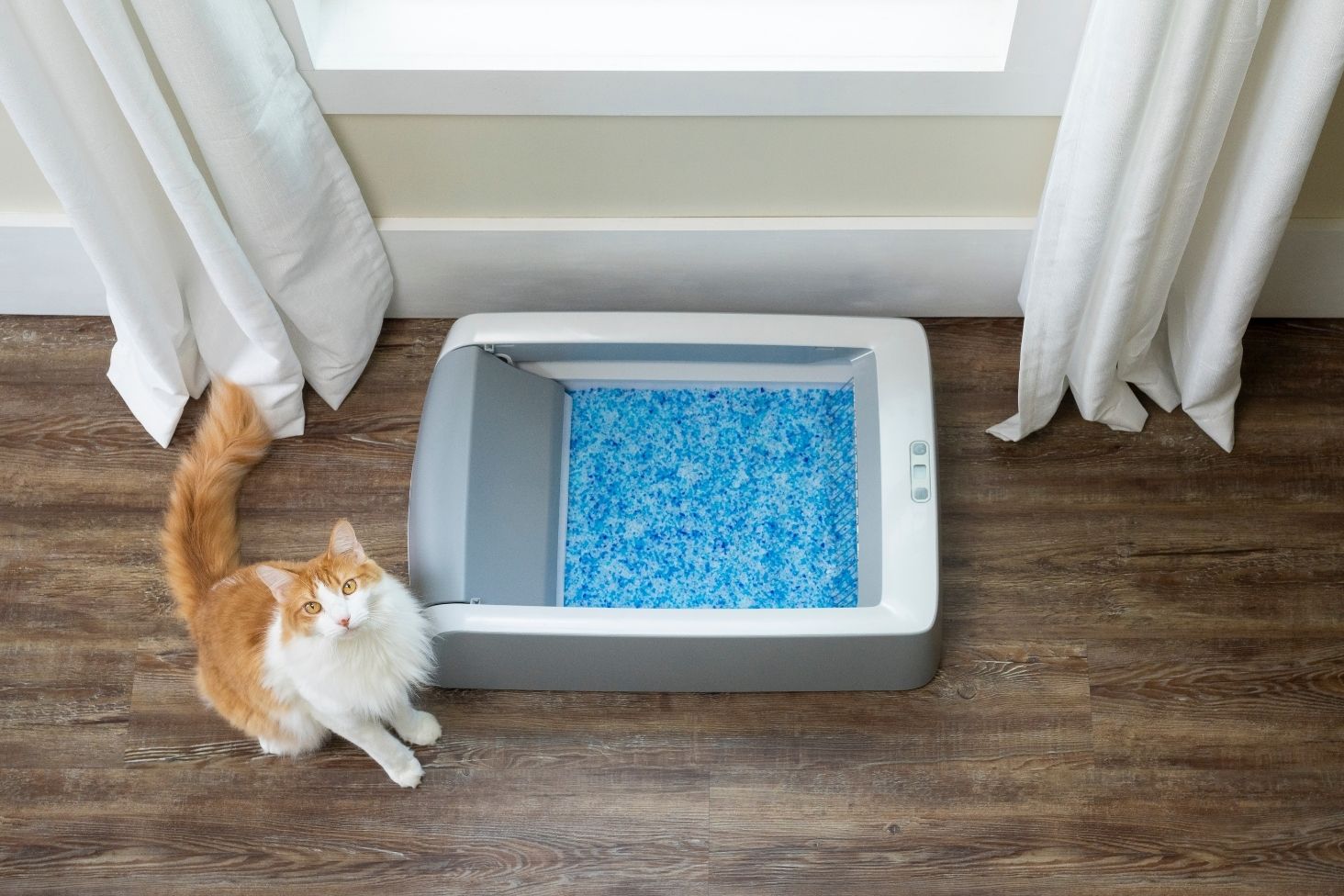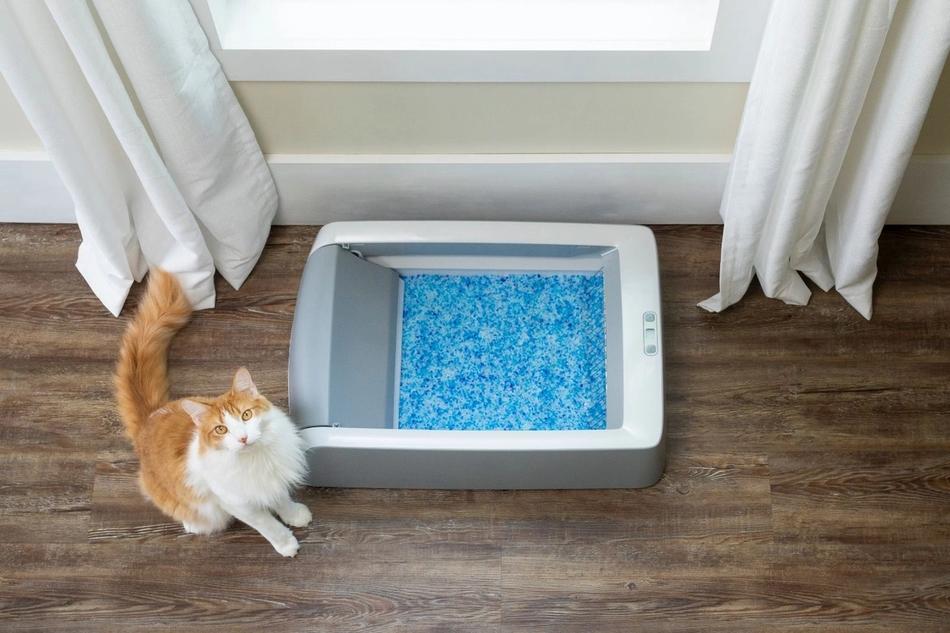What does your cat’s litter box have in common with prime real estate property? It’s all about location, location, location! Where to put a litter box is a common conundrum for cat lovers everywhere. While many of us feel inclined to hide the litter box away from the world, it’s important to think about what’s best for your cat, as well as how the litter box is meant to work. Being thoughtful about where you place the litter box will help you, your cat, and the rest of the family live with the litter box more comfortably.

Find a Private Location
Cats are like us in that they prefer some privacy when they go to the bathroom. This means choosing a location, if possible, where your cat can have some alone time without people or dogs dropping in. If there are rooms in your house that don’t get much daily traffic, such as a spare bedroom, consider these. What about where to put the litter box in a small apartment? If you don’t have rooms to spare, consider a covered litter box. A simple hood that encloses the litter box can give your cat her own little private potty cave. Special furniture is also available to discreetly hide the litter box in plain sight, such as hollow end tables or ottomans with an opening on one end where kitties can sneak inside.
Choose a Quiet Place
Cats are often timid and wary of loud noises. For this reason, it’s best to avoid placing the litter box in noisy places like near the TV, speakers, or the washing machine. Spooking your cat with an abrupt sound while she’s trying to go is a sure way to condition her to avoid the litter box, setting yourself up for potty accidents elsewhere in your home. Choose a consistently quiet spot to ensure your cat will not get an unexpected scare when she’s doing her business.
Make Sure the Litter Box is Easy to Access
Let’s face it; we’ve all been there… nothing’s worse than urgently needing a bathroom and not having one handy. Our cats feel the same way. Just as we like to have a bathroom available whenever we need it, your cat will benefit from having an easily accessible litter box. Avoid areas where obstacles might show up, such as spots where laundry piles up or where doors may be opened and closed frequently. As with loud noises, presenting unexpected obstacles in front of the litter box is a recipe for bathroom accidents. Think about the path your cat will take to get to her litter box, and observe her to make sure she can get to it easily.
Place the Litter Box Away from Cat Food
Once again, we’re reminded that our cats are a lot like us… they prefer not to potty where they eat. This might seem like a no-brainer, but cat parents are often tempted to place the food, water and litter box close together for convenience. Ideally, your cat’s litter box should be in a different part of your home than her food and water. This goes for dog food, too – many dogs are inexplicably tempted to snack on litter box contents, and placing the box next to Fido’s food bowl only makes these forbidden morsels more tantalizing. To summarize, it’s generally a good idea to keep the box of poop away from everyone’s dinner.
Keep One Litter Box on Each Floor
Part of making sure the litter box is accessible means considering multiple litter boxes. As a rule of thumb, it’s ideal to have one litter box per cat in your home plus one extra. This helps ensure there is always a clean, vacant potty available for each kitty when she’s ready to go. If you have a multi-level home, a good way to approach the multiple litter box strategy is to place a litter box on each floor. As discussed, you should minimize obstacles to litter box access, and removing stairs from the equation is one way to accomplish this.
Remember to Keep Doors Open
There’s nothing more frustrating than rushing to the restroom only to find the door is locked. That’s how our cats feel when their litter box is behind an accidentally shut door. Forgetfully shutting the door to the litter box room is high on the list of causes for kitty bathroom accidents. For this reason, spaces like closets are risky spots for litter box placement; it’s too easy for guests (or even us before coffee!) to close the door and inadvertently block access to the litter box. It’s best to put the litter box in a space that can’t be so easily blocked by a closing door; however, this tactic may not work in your space. Luckily, there are some workarounds. One of the most effective is to install an indoor cat door. This allows you to close the (human) door completely to the room where the litter box stays, providing a reliable opening that only the cat can fit through. This offers an added bonus of keeping curious dogs and children away from the litter box, too. Plus, your cat will appreciate the privacy. A win-win-win!
Avoid Humid Locations
Surprisingly, some of the most popular litter box locations are not necessarily the best for optimal litter box function. Technically speaking, one of the basic ways any cat litter works is to absorb moisture (and therefore odor) from your cat’s waste. Because of this, popular litter box hideaways like the bathroom, the basement or the laundry room can actually be problematic. Excess humidity means extra moisture in the air. Cat litter will absorb this moisture and become soiled or saturated more quickly as a result. Odor will be worse, and litter will have to be changed more often. Keep this in mind when you choose a litter box location. Counterintuitive as it may seem, placing the litter box in a well-ventilated area like a living room can actually help reduce odor and prolong the life of your litter, by helping it stay drier, longer. Consider your local climate, too – if you live in a naturally wet place like Seattle, London or the Amazon rainforest, keeping your litter box near an open window can result in a dramatic reduction in litter life!
Move the Litter Box if Accidents Continue
An important step in choosing the best place to put a litter box is observation. Watch your cat’s behavior and try to keep track of her litter box use, especially when you first set up a new litter box. Make sure she seems comfortable entering and leaving the box and that she doesn’t have any trouble getting to it. If it seems like your cat is not finding the box or she’s choosing to potty outside the box, consider trying a new location. When moving the litter box, be sure to take baby steps. Move the box a little at a time so your cat can keep track of it. Alternatively, you can leave the original box where it is and set up a new litter box in your new chosen location. That way she can decide where she prefers to go. Once you determine she’s routinely using the new location, you can remove the old box.
Getting the litter box location just right can feel like a balancing act sometimes, weighing privacy and seclusion against ventilation and ease of access. When you get the balance right, your cat will thank you by routinely going where she’s supposed to, meaning a comfortable cat and no more potty accidents in your home.





